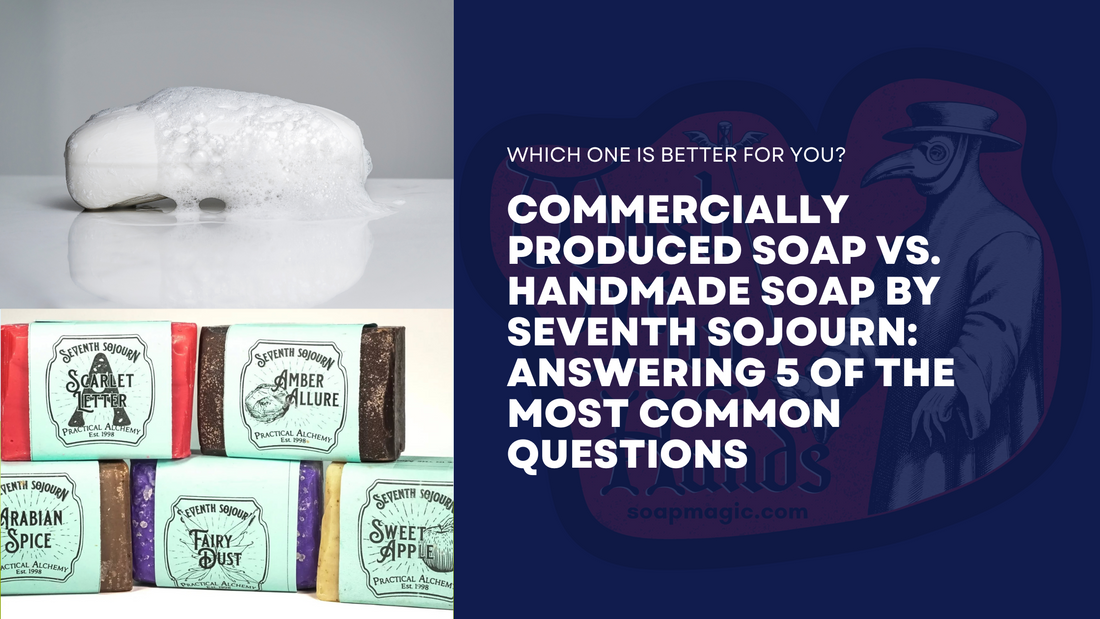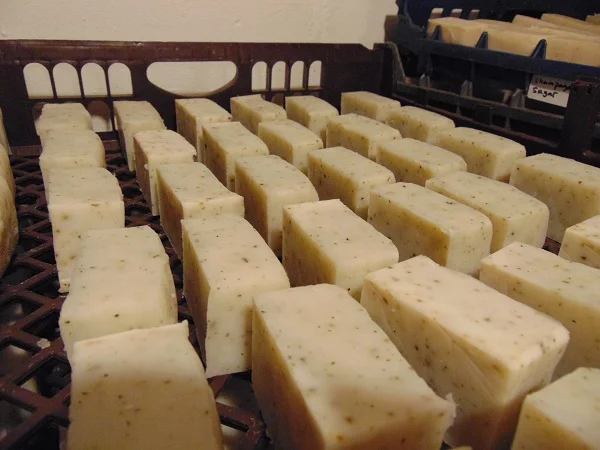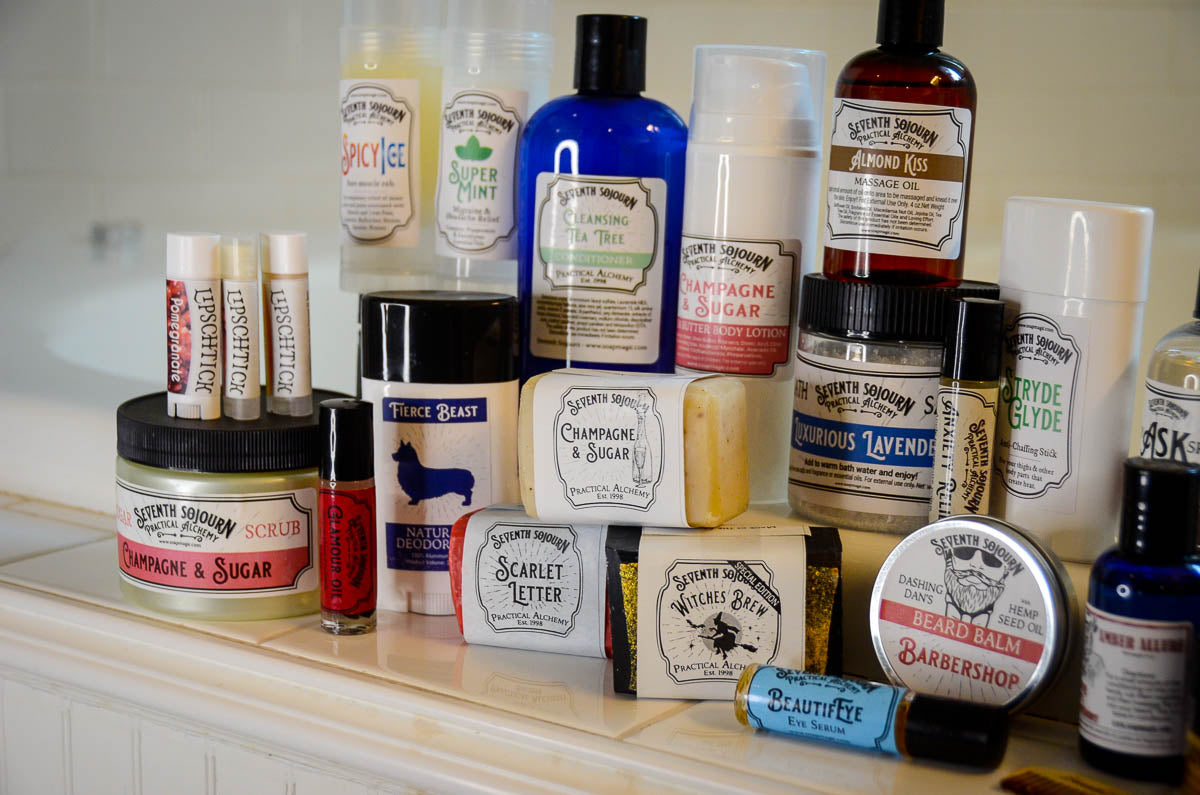
Commercially Produced Soap VS. Handmade Soap by Seventh Sojourn: Answering 5 of the Most Common Questions
Share
Does your local store carry soap that often leaves your skin feeling dryer than the Sahara Desert? Does the lather leave a white layer of mystery on your skin instead of clear, bubbly goodness? Does your post-shower experience include the type of itching that might make onlookers think that ants are colonizing on your skin? Yikes!
For 20 years, Seventh Sojourn has worked hard to ensure that both your shower AND post shower experiences are not only pleasant, but truly enjoyable. We’ve been asked numerous questions about the difference between our soaps and commercially produced soaps you can find on the shelf of your favorite store. In the spirit of these conversations, we’ve decided to share this information with the rest of you in hopes that it helps someone make a change that benefits their skin health for years to come.

Q1) Why does commercial soap make my skin “zombie dry?”
A lot of information has become readily available about the importance of Glycerin in soap. Glycerin is not only the #1 moisturizer in soap, but it’s also an emollient (skin softener) and humectant, which draws added moisture to it.
Commercial soap producers often remove varying levels of Glycerin to lower production costs in other products that provide them with better sales margins; such as lotion, shampoo, etc.
The Glycerin naturally produced in Seventh Sojourn Soaps through the saponification process stays put, right where it belongs. Additionally, we insulate newly poured soap, which keeps the Glycerin from evaporating during the curing process. This allows our customers to enjoy the full benefit of soap’s most skin-loving ingredient.
Q2) Isn’t handmade soap much more expensive than commercial soaps?
The short answer is no. Although one bar of handmade soap may cost about the same as a 3 or 4 pack of commercially produced soap, the commercially produced soap breaks down and disintegrates much quicker. This is usually due to low quality base ingredients, or even the extraction of Glycerin that we talked about in the paragraph above.
Commercial soap manufacturers tend to use the lowest cost base ingredients possible to cut overhead. While this may seem to allow them to offer a price point that is unmatched by handmade soaps, the long-lasting nature of a handmade bar of Seventh Sojourn Soaps balances in cost. You don’t have to go any further than our customer reviews to see proof of our soap’s durability.



The Curing Process: Seventh Sojourn cures our soap in a climate controlled area, allowing each bar of soap to last much longer than commercial soaps.
Q3) Okay Seventh Sojourn, which ingredients in your soap make it better than commercial soaps?
It’s not like we’ve found these secret ingredients that nobody has heard of before. In fact, handmade soap quality is better for you than commercial because of the ingredients we DON’T use.
Commercial soaps are full of toxic ingredients, such as propylene glycol, which is said to cause skin conditions such as dermatitis and eczema. Other harmful ingredients in commercial soaps include: parabens (chemical preservatives), phthalates (used to produce plastic), petrochemicals (potential long-term effects), synthetic perfumes (allergies, hormonal issues, acne causing), and artificial dyes (potentially cancer causing.)
Seventh Sojourn Soaps use 5 natural base ingredients: tallow, olive oil, coconut oil, raw silk and shea butter. All of which are beneficial and when combined, create the skin-loving goodness you’ve come to know and love. Feel free to look up all the positive impacts these ingredients have on your skin. There are literally so many that we could fill a whole blog with this information alone! Hmmm…good idea….
Q4) Isn’t lye extremely toxic? Does Seventh Sojourn use lye to create their soap?
If you were to put lye directly on your skin in its natural form, let’s just say that you wouldn’t be a very happy camper. But lye is added to the soap mixture before the saponification process. Once saponification occurs, the lye reacts with the other oils and nullifies its chemical properties. This reaction creates the natural cleaning agent that makes soap a body cleanser.
Truth be told, handmade bar soap is the BEST method to cleanse your skin. Most liquid soaps and body soaps do not contain natural cleansers, and therefore do not clean your body but perfume it instead, covering up the dirt and grime.
Q5) I just bought a specialty “facial bar.” Match that, Seventh Sojourn!
We hate to “wash” away your hopes, but facial bars and beauty bars are called these things for a reason, and that reason is not because of a significant increase in quality. If you find a bar with a fancy title that doesn’t include the designation of soap, it most often means that it contains one or more harmful ingredients that are regulated by the CPSC (Consumer Product Safety Commission) and by law, can no longer mislead you by carrying the designation of “soap.” Therefore, the commercial manufacturers slap a fancy, misleading designation that makes it sound as if the quality is far superior, even though the quality of the soap is very poor.
The next time you’re in your favorite local store, take a look at the ingredients and titles of the various different commercially manufactured soaps. Can you pronounce the ingredients? Is that product even soap?
Its not our goal to scare you, but we do want to inform you about what you put on your skin and body! Everyone is loved by someone, and every one of our bars of soap is handmade with love. We want you to stay on this Earth as long as possible, and we enjoy providing you with products that allow you to pamper yourself and take care of your skin and health along the way.

